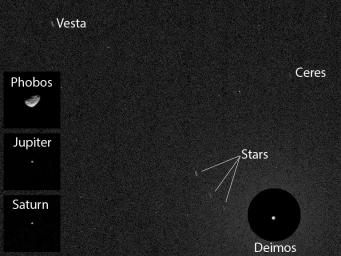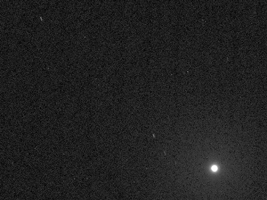
|
First Asteroid Image from the Surface of Mars
- Click the image above for a larger view
- Full-Res JPEG (768 x 576) (121.2 kB)
- Full-Res TIFF (768 x 576) (443.0 kB)
Caption:

Unannotated Version
Click on the image for larger version
The Mast Camera (Mastcam) on NASA's Curiosity Mars rover has captured the first image of an asteroid taken from the surface of Mars. The night-sky image actually includes two asteroids: Ceres and Vesta, plus one of Mars' two moons, Deimos, which may have been an asteroid before being captured into orbit around Mars. The image was taken after nightfall on the 606th Martian day, or sol, of Curiosity's work on Mars (April 20, 2014, PDT). In other camera pointings the same night, the Mastcam also imaged Mars' larger moon, Phobos, plus the planets Jupiter and Saturn.
Ceres, with a diameter of about 590 miles (950 kilometers), is the largest object in the asteroid belt, large enough to be classified as a dwarf planet. Vesta is the third-largest object in the asteroid belt, about 350 miles (563 kilometers) wide. These two bodies are the destinations of NASA's Dawn mission, which orbited Vesta in 2011 and 2012 and is on its way to begin orbiting Ceres in 2015.
This annotated image combines portions of images taken at the same pointing with two different exposure times, plus insets from other camera pointings. In the main portion of the image, Vesta, Ceres and three stars appear as short streaks due to the duration of a 12-second exposure. The background is detector noise, limiting what we can see to magnitude 6 or 7, much like normal human eyesight. The two asteroids and three stars would be visible to someone of normal eyesight standing on Mars. Specks are effects of cosmic rays striking the camera's light detector.
Three square insets at left show Phobos, Jupiter and Saturn at exposures of one-half second each. Deimos was much brighter than the visible stars and asteroids in the same part of the sky, in the main image. The circular inset covers a patch of sky the size that Earth's full moon appears to observers on Earth. At the center of that circular inset, Deimos appears at its correct location in the sky, in a one-quarter-second exposure. In the unannotated version of the 12-second-exposure image, the brightness of Deimos saturates that portion of the image, making the moon appear overly large.
Background Info:
NASA's Jet Propulsion Laboratory, a division of the California Institute of Technology, Pasadena, manages the Mars Science Laboratory Project for NASA's Science Mission Directorate, Washington. JPL designed and built the project's Curiosity rover and the rover's Navcam.
More information about Curiosity is online at http://www.nasa.gov/msl and http://mars.jpl.nasa.gov/msl/ .
Cataloging Keywords:
| Name | Value | Additional Values |
|---|---|---|
| Target | 1 Ceres | 4 Vesta, Deimos, Phobos |
| System | Main Belt | |
| Target Type | Dwarf Planet | Asteroid, Satellite |
| Mission | Dawn | |
| Instrument Host | Dawn | Curiosity Rover |
| Host Type | Orbiter | Rover |
| Instrument | Mast Camera (MastCam) | |
| Detector | ||
| Extra Keywords | Grayscale | |
| Acquisition Date | ||
| Release Date | 2014-04-24 | |
| Date in Caption | 2014-04-20 | |
| Image Credit | NASA/JPL-Caltech/MSSS/Texas A&M | |
| Source | photojournal.jpl.nasa.gov/catalog/PIA17937 | |
| Identifier | PIA17937 | |
